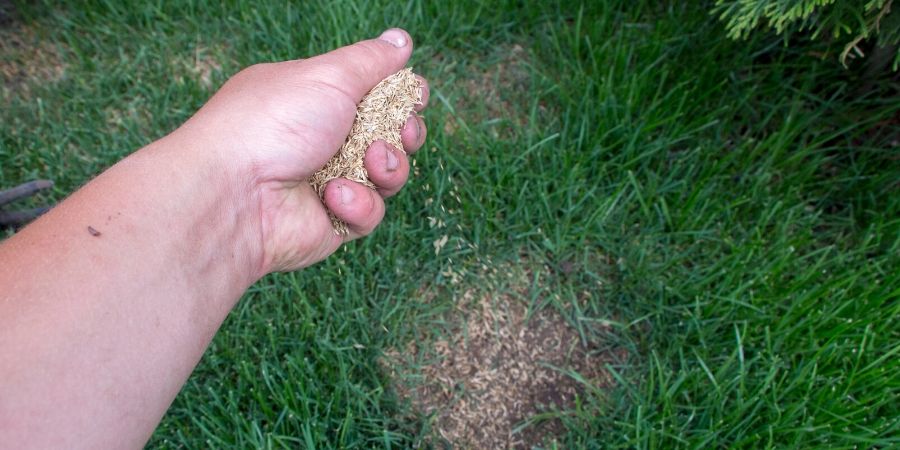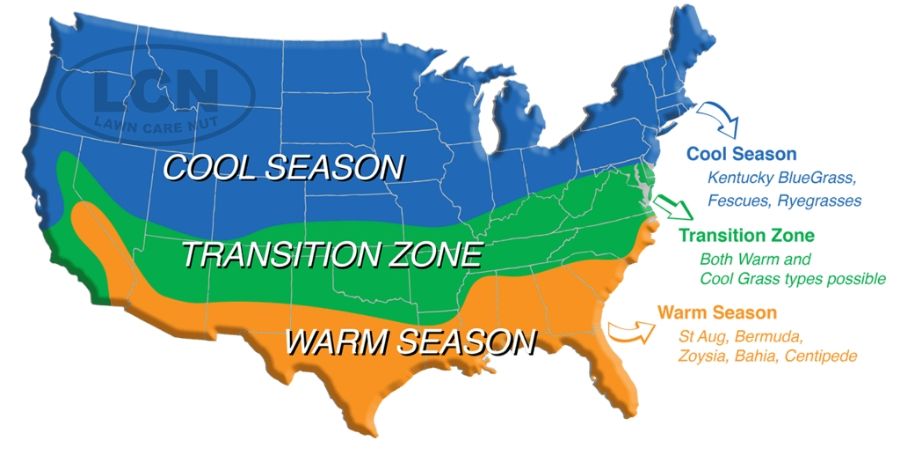Ask the Agronomist: Grass Seed Q&A
- Milorganite AgronomistMay 9, 2020
What’s the best grass for lawns?
Selecting the best grass seed variety for your yard will impact its future success, whether you’re installing a new lawn, overseeding, renovating a tired lawn or patching bare spots.
I’m often asked, “What is the best type of grass seed to use for lawns?” There is no simple answer. There isn’t a best or perfect grass variety for lawns. It depends on a number of factors.
The following questions and information will help you narrow down your choice of grass varieties suitable for your area and help you make the decision of which are best suited for growing YOUR lawn.
Should I choose a cool-season or warm-season grass variety?
Each grass variety thrives in particular climates and growing conditions, with heat and drought tolerance being two major factors to consider. Location and climate will determine whether Northern, cool-season grass or Southern, warm-season grass varieties, or mix of varieties, will do well in your yard.
Cool-season grass seed varieties, which are best for Northern lawns, thrive in the 60-75°F range and include varieties such as Kentucky Bluegrass, Ryegrass and Fescues. These varieties are able to withstand cold, winter weather.
Warm-season grass seed varieties, those best for Southern lawns, grow in hot, as well as subtropical to tropical climates, and include Bermudagrass, St. Augustine, and Zoysia, which thrive in summer temperatures of 80-95°F. Although these varieties may turn brown in cold weather, they green-up again with the return of warmer temperatures.
There isn’t a clear dividing line across the country delineating which grass varieties grow in the North and which grow in the South. There’s a transition zone in which cool-season and/or warm-season grasses may grow well depending on local climates.
The National Turfgrass Evaluation Program provides a map that allows you to select your state for information on grass varieties that have been tested there. It also provides a wealth of evaluation data for those who like to get into the weeds. (Sorry. I had to say it.) With a quick search, you can find other turfgrass climate zone maps for additional information.
What’s the best grass variety?
The “best” grass variety for your yard depends on all of the conditions mentioned below. I recommend purchasing a mix of grass seed varieties. You’re hedging your bet by not relying on a single variety of grass to do well.
There are vast differences in grass varieties, with regard to characteristics such as disease resistance and drought tolerance. Using a single grass variety can put your lawn at risk. If it develops a disease, for example, your entire lawn may be at risk. A mix helps to balance the pros and cons of each variety.
If you’d like advice on which grass varieties grow in your area, contact your local extension agency and they should be able to provide you with information.
What are the best grass varieties for my property?
After determining which grass varieties will grow well in your area, it’s time to survey your property and take note of growing conditions. Different varieties of grass have preferred conditions in which they grow best.
Consider, for example, the areas of your yard that are in full sun, full shade or a combination. Also consider whether your property is generally wet or well-drained, or prone to flooding or drought. The soil composition of your yard, as well as soil fertility, are factors in determining the best grass varieties for your property. Salt-air tolerance is an important factor in coastal areas.
Match the conditions of your yard to grass varieties that have characteristics you’re looking for. I recommend a mix of grass varieties that will cover a variety of growing conditions in your yard.
How do you use your yard?
Your lifestyle, how you’re going to use your yard, will impact the grass varieties you choose. Some varieties can withstand high-traffic, such as areas frequented by kids and dogs. Other varieties will provide the picturesque carpet-like lawn you’re looking for, which gets very little traffic.
When is the best time to seed or overseed my lawn?
The best time of year to seed or overseed a lawn in the North is while summer slips into fall, because the temperatures are ideal for grass to germinate and establish itself before winter. Although fall is the best time to spread grass seed in the North, spring is your second-best option.

In the North, grass seed germinates when soil temperatures are in the mid-50s and daytime air temperatures are in the low- to mid-70s. You can easily check the current soil temperatures online by simply entering your zip code.
The optimal time to spread grass seed in the transition zone or South depends on local growing conditions. In some areas in Florida, for example, seeding can be done almost year-round, when the grass is actively growing and there’s plenty of rain.
It’s easier to broadcast grass seed using a spreader by mixing four parts of Milorganite with one part grass seed, both by weight. This will help you see where the tiny grass seeds have been spread and provides an initial feeding. Milorganite is non-burning and won’t harm tender seedlings.
How do I read a grass seed label?
There’s a lot of valuable analysis information printed on grass seed labels, which is required by law. Interpreting the information will make more sense when you know what data to look for.
Here’s the key information to look for on grass seed labels.
- Weed Seeds are those not covered under Components or Other Crops. Grass seed should contain no more than 0.5% weed seeds.
- Noxious Weed Seeds refers to hard-to-control weeds in turf that are defined by state laws. Seed that’s been tested against noxious weed laws in all states is best. “None found” indicates quality seed.
- Inert Matter is the percentage of material that’s not going to grow, such as stems and chaff. Like weed seeds, the percentage of inert matter should be no more than 0.5% and indicates better seed quality
- Other Ingredients are agricultural crop seeds and other components not listed under Purity. Quality seed contains no objectionable crop seed, which can be problematic in turf.
Here are two resources that provide an explanation of all of the information you’ll find on grass seed labels. The U.S. Department of Agriculture, Natural Resources Conservation Service offers a guide, A Simplified Guide to Understanding Seed Labels, which defines all of the information found on grass seed labels.
What brand of grass seed to you recommend?
Another question I hear is, “What is the best brand of grass seed?” Unfortunately, I don’t know all of the grass seed producers throughout the country and can’t answer the question with any confidence.
With a better understanding of how to read grass seed labels, you’ll be able to base your decision on which grass seed to purchase based on seed quality, rather than what company is selling it. I recommend purchasing grass seed that’s grown regionally, which is most often the case.
SUMMARY
There is no “perfect” or “best” grass seed varieties. There are many factors to consider, including climate, soil conditions and lifestyle. Being able to interpret information on grass seed labels and doing a bit of research, you’ll be able to find the best mix of grass seed varieties for your yard. Although fall is the best time to spread grass seed in most areas of the country, similar spring weather conditions make spring an acceptable alternative.


